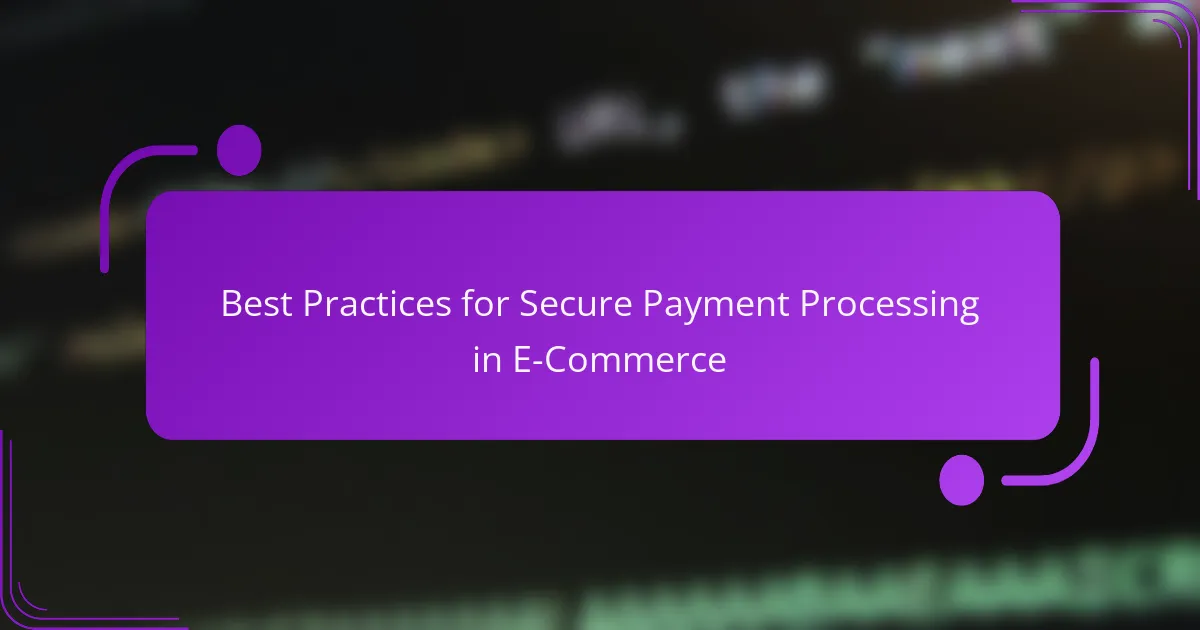In the rapidly evolving world of e-commerce, secure payment processing is vital for safeguarding customer information and fostering trust. By adopting best practices, businesses can significantly mitigate the risks of fraud and data breaches, ensuring a safe shopping experience for their customers.
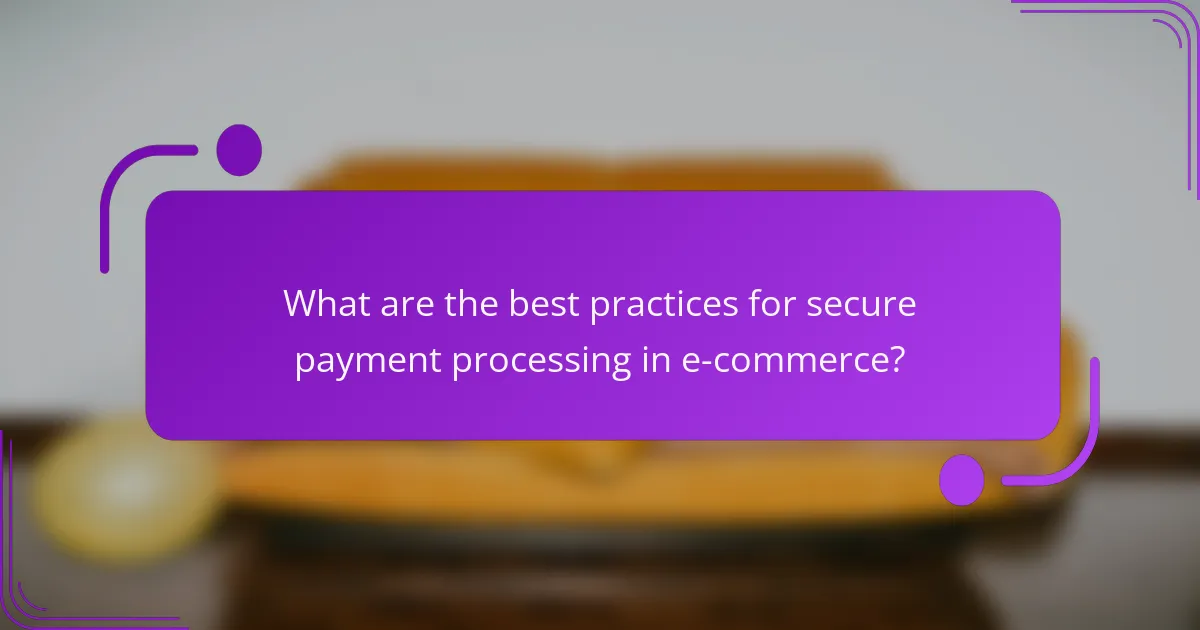
What are the best practices for secure payment processing in e-commerce?
Secure payment processing in e-commerce is essential to protect customer information and maintain trust. Implementing best practices can significantly reduce the risk of fraud and data breaches.
Use SSL certificates for data encryption
SSL certificates encrypt data transmitted between the customer and the e-commerce site, ensuring that sensitive information like credit card details is secure. This encryption makes it difficult for unauthorized parties to intercept or read the data.
To implement SSL, purchase a certificate from a trusted Certificate Authority (CA) and install it on your web server. Ensure that your website URL begins with “https://” to indicate that it is secure.
Implement PCI DSS compliance
PCI DSS (Payment Card Industry Data Security Standard) compliance is a set of security standards designed to protect card information during and after a financial transaction. Adhering to these standards is crucial for any business that processes credit card payments.
To achieve compliance, businesses must follow guidelines such as maintaining a secure network, implementing strong access control measures, and regularly monitoring and testing networks. Non-compliance can lead to hefty fines and increased liability in case of a data breach.
Utilize tokenization for sensitive data
Tokenization replaces sensitive payment information with a unique identifier or token that cannot be used outside the specific transaction context. This reduces the risk of exposing actual card details during processing.
Implementing tokenization can be particularly beneficial for recurring billing or subscription services, as it allows businesses to store tokens instead of sensitive data, minimizing the risk of data breaches.
Adopt multi-factor authentication
Multi-factor authentication (MFA) adds an extra layer of security by requiring users to provide two or more verification factors to access their accounts. This greatly reduces the likelihood of unauthorized access.
Common methods of MFA include SMS codes, email confirmations, or authentication apps. Implementing MFA can be a straightforward yet effective way to enhance security for both customers and merchants.
Regularly update security protocols
Regularly updating security protocols is vital to protect against emerging threats and vulnerabilities. This includes keeping software, payment gateways, and security systems up to date with the latest patches and updates.
Establish a routine schedule for reviewing and updating security measures. Consider conducting regular security audits and penetration testing to identify and address potential weaknesses in your payment processing system.
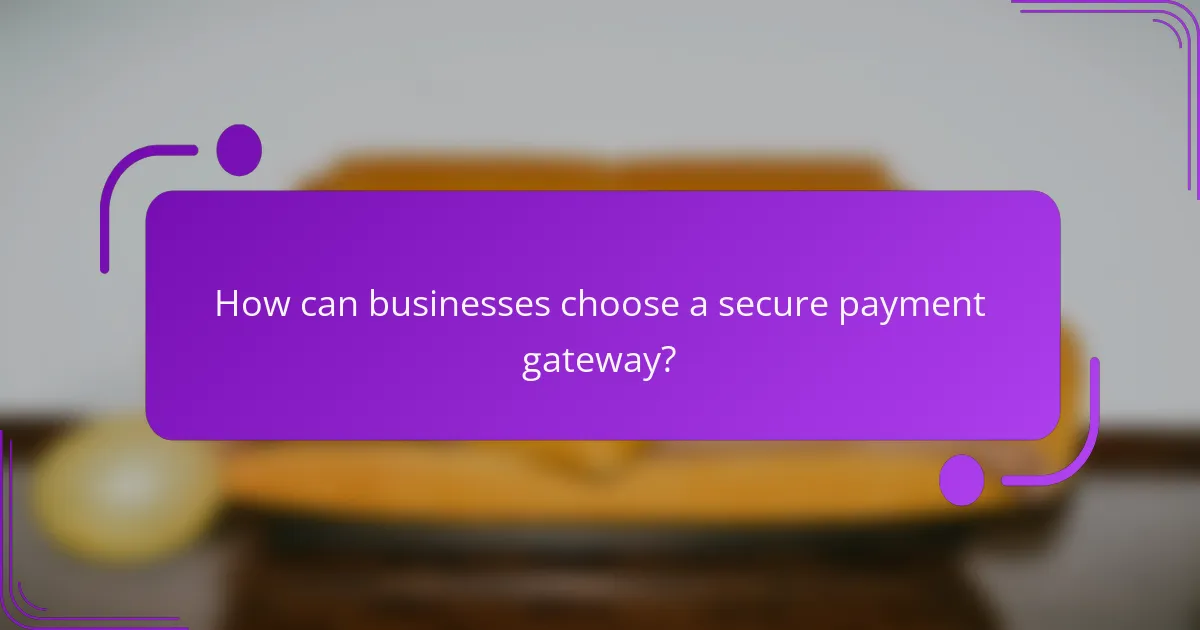
How can businesses choose a secure payment gateway?
Businesses can choose a secure payment gateway by assessing its security features, transaction costs, and integration capabilities with existing platforms. A well-selected gateway not only protects customer data but also optimizes transaction efficiency and aligns with business needs.
Evaluate security features of gateways
When evaluating security features, look for gateways that comply with Payment Card Industry Data Security Standards (PCI DSS). Features such as encryption, tokenization, and fraud detection tools are essential for safeguarding sensitive customer information.
Additionally, consider gateways that offer two-factor authentication (2FA) and regular security audits. These features enhance the overall security posture and help in mitigating risks associated with online transactions.
Compare transaction fees and costs
Transaction fees can vary significantly between payment gateways, typically ranging from 1.5% to 3.5% per transaction. It’s crucial to analyze not just the percentage but also any additional fees, such as monthly service charges or setup costs.
Some gateways may offer lower transaction fees but charge higher monthly fees, while others might have no monthly fees but higher per-transaction costs. Calculate the total cost based on your expected transaction volume to find the most cost-effective solution.
Check integration capabilities with platforms
Ensure the payment gateway can easily integrate with your existing e-commerce platform, whether it’s Shopify, WooCommerce, or Magento. A seamless integration reduces setup time and minimizes potential technical issues.
Look for gateways that provide plugins or APIs specifically designed for your platform. This compatibility can enhance user experience and streamline the checkout process, ultimately leading to higher conversion rates.
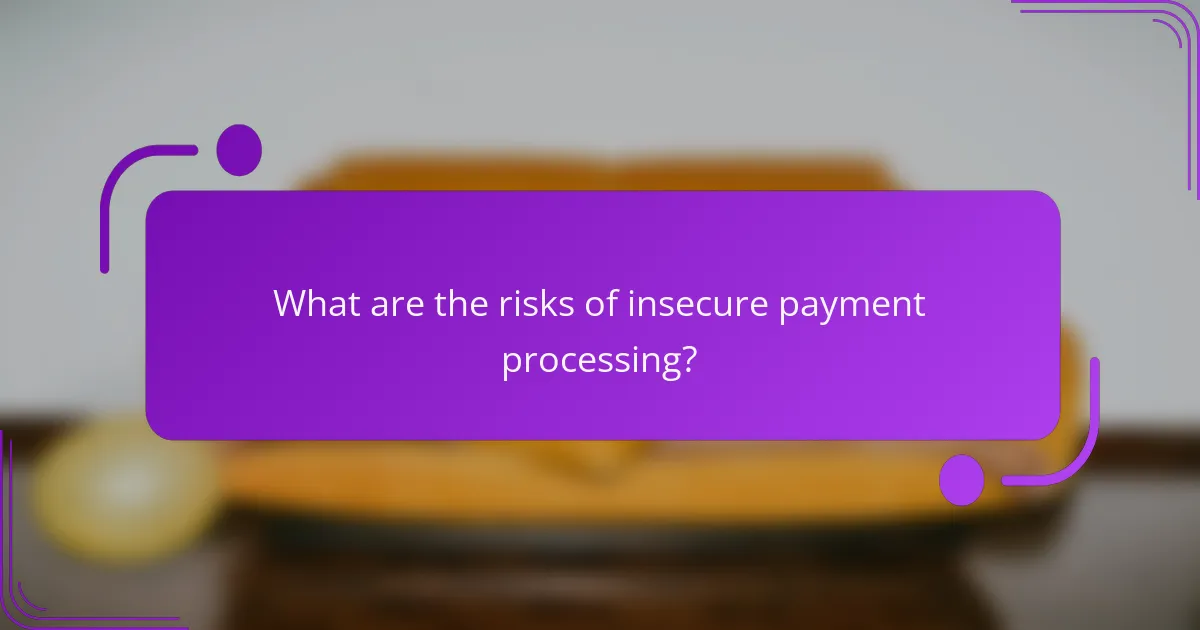
What are the risks of insecure payment processing?
Insecure payment processing exposes e-commerce businesses to various risks, including financial loss, damage to customer trust, and potential legal repercussions. Understanding these risks is crucial for implementing effective security measures.
Data breaches leading to financial loss
Data breaches can result in significant financial losses for e-commerce businesses. When sensitive payment information is compromised, companies may face direct theft of funds, as well as costs related to fraud detection, remediation, and potential compensation to affected customers.
For example, a breach could lead to unauthorized transactions, which may require businesses to refund customers and absorb the losses. Additionally, the costs of investigating and resolving the breach can escalate quickly, often reaching thousands to millions of dollars.
Loss of customer trust and reputation
Insecure payment processing can severely damage customer trust and a company’s reputation. Once customers learn about a data breach or security incident, they may hesitate to share their payment information in the future, leading to decreased sales.
Restoring customer confidence can be a lengthy and costly process. Businesses may need to invest in marketing campaigns to reassure customers, as well as enhance their security measures to prevent future incidents.
Legal consequences from non-compliance
Failure to comply with payment processing regulations can lead to serious legal consequences for e-commerce businesses. Regulations such as the Payment Card Industry Data Security Standard (PCI DSS) require strict adherence to security protocols to protect customer data.
Non-compliance can result in hefty fines, legal actions, and increased scrutiny from regulatory bodies. Businesses may also face lawsuits from customers whose data has been compromised, further complicating their legal standing and financial health.
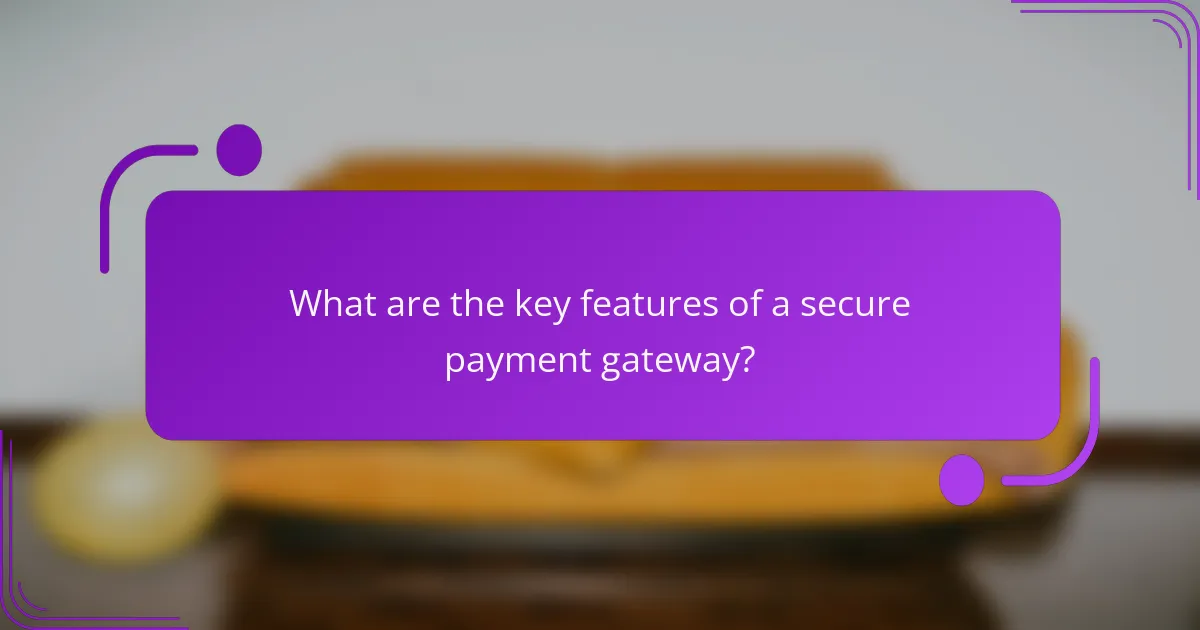
What are the key features of a secure payment gateway?
A secure payment gateway is essential for protecting sensitive customer information during online transactions. Key features include robust encryption, compliance with industry standards, and tools for fraud detection and prevention.
Fraud detection and prevention tools
Fraud detection and prevention tools are critical for identifying and mitigating fraudulent transactions. These tools often utilize machine learning algorithms to analyze transaction patterns and flag suspicious activities in real-time.
Common features include address verification systems (AVS), card verification value (CVV) checks, and geolocation tracking. Implementing these tools can significantly reduce the risk of chargebacks and financial losses.
Support for multiple payment methods
Support for multiple payment methods enhances customer convenience and can lead to increased sales. A secure payment gateway should accommodate various options such as credit and debit cards, digital wallets, and bank transfers.
Consider integrating popular payment methods relevant to your target market, such as PayPal, Apple Pay, or local options like Sofort in Europe. This flexibility can cater to diverse customer preferences and improve the overall shopping experience.
Real-time transaction monitoring
Real-time transaction monitoring allows businesses to track transactions as they occur, providing immediate insights into payment activity. This feature helps identify potential issues quickly, enabling swift action to prevent fraud.
Monitoring tools can alert merchants to unusual patterns, such as multiple transactions from the same IP address or sudden spikes in transaction volume. Regularly reviewing these alerts can help maintain a secure payment environment.
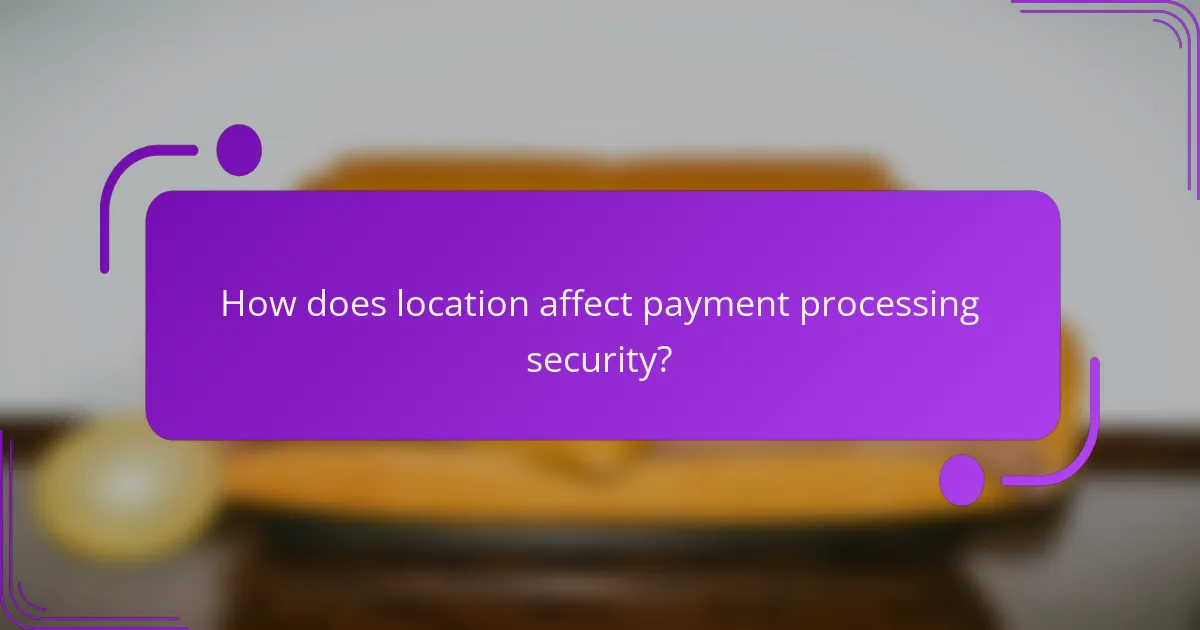
How does location affect payment processing security?
Location significantly impacts payment processing security due to varying regulations, fraud risks, and technological infrastructure. Different countries have distinct laws governing data protection and payment transactions, which can influence the security measures that e-commerce businesses must adopt.
Regulatory Differences
Each country has its own set of regulations that govern payment processing. For instance, the European Union enforces the General Data Protection Regulation (GDPR), which mandates strict data protection measures. In contrast, the United States has a more fragmented regulatory landscape, with varying state laws that can affect how payments are processed securely.
Businesses must stay informed about local regulations to ensure compliance. Non-compliance can lead to hefty fines and damage to reputation. It’s advisable to consult with legal experts familiar with the payment landscape in the specific regions where you operate.
Fraud Risks by Region
Fraud risks can vary significantly based on location. Regions with higher rates of online fraud may require additional security measures, such as multi-factor authentication or advanced fraud detection tools. For example, countries in Eastern Europe might experience higher levels of card-not-present fraud compared to Western Europe.
Understanding the fraud landscape in your target markets can help you tailor your security strategies effectively. Regularly reviewing fraud trends and adapting your approach can mitigate risks and protect your business.
Technological Infrastructure
The technological infrastructure available in a location can affect payment processing security. Regions with advanced payment technologies, such as tokenization and encryption, can offer more secure transaction environments. Conversely, areas with outdated systems may expose businesses to greater vulnerabilities.
Investing in robust payment processing solutions that align with the technological capabilities of your target market is crucial. Ensure that your payment gateway supports the latest security protocols to safeguard customer data during transactions.
